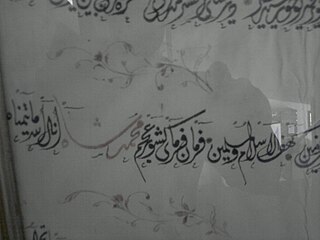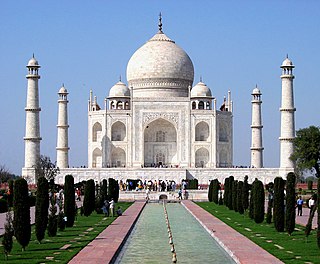The Persians are an Iranian ethnic group who comprise the majority of the population of Iran. They share a common cultural system and are native speakers of the Persian language as well as of the languages that are closely related to Persian.

Tajiks are a Persian-speaking Iranian ethnic group native to Central Asia, living primarily in Afghanistan, Tajikistan, and Uzbekistan. Tajiks are the largest ethnicity in Tajikistan, and the second-largest in Afghanistan and Uzbekistan. More Tajiks live in Afghanistan than Tajikistan. They speak varieties of Persian, a Western Iranian language. In Tajikistan, since the 1939 Soviet census, its small Pamiri and Yaghnobi ethnic groups are included as Tajiks. In China, the term is used to refer to its Pamiri ethnic groups, the Tajiks of Xinjiang, who speak the Eastern Iranian Pamiri languages. In Afghanistan, the Pamiris are counted as a separate ethnic group.
Iranians or Iranian people may refer to:

Pakistan is a multilingual country with over 70 languages spoken as first languages. The majority of Pakistan's languages belong to the Indo-Iranian group of the Indo-European language family.

The Dardic languages, or Hindu-Kush Indo-Aryan languages, are a group of several Indo-Aryan languages spoken in northern Pakistan, northwestern India and parts of northeastern Afghanistan. This region has sometimes been referred to as Dardistan.

ʿAjam is an Arabic word for a non-Arab, especially a Persian. It was historically used as a pejorative—figuratively ascribing muteness to those whose native language is not Arabic—during and after the Muslim conquest of Iran. Since the early Muslim conquests, it has been adopted in various non-Arabic languages, such as Turkish, Azerbaijani, Chechen, Kurdish, Malay, Sindhi, Urdu, Bengali, Punjabi, Kashmiri, and Swahili. Today, the terms ʿAjam and ʿAjamī continue to be used to refer to anyone or anything Iranian, particularly in the Arab countries of the Persian Gulf. Communities speaking the Persian language in the Arab world exist among the Iraqis, the Kuwaitis, and the Bahrainis, in addition to others. A number of Arabs with Iranian heritage may have the surname ʿAjamī (عجمي), which has the same meaning as the original word.
The term Aryan language appears in works published in the 19th century and 20th century to mean very old Indo-European languages:

Indo-Persian culture refers to a cultural synthesis present on the Indian subcontinent. It is characterised by the absorption or integration of Persian aspects into the various cultures of modern-day republics of Bangladesh, India, and Pakistan. The earliest introduction of Persian influence and culture to the subcontinent was by various Muslim Turko-Persian rulers, such as the 11th-century Sultan Mahmud Ghaznavi, rapidly pushed for the heavy Persianization of conquered territories in northwestern Indian subcontinent, where Islamic influence was also firmly established. This socio-cultural synthesis arose steadily through the Delhi Sultanate from the 13th to 16th centuries, and the Mughal Empire from then onwards until the 19th century. Various dynasties of Turkic, Iranian and local Indian origin patronized the Persian language and contributed to the development of a Persian culture in India. The Delhi Sultanate developed their own cultural and political identity which built upon Persian and Indic languages, literature and arts, which formed the basis of an Indo-Muslim civilization.

The Iranian languages, also called the Iranic languages, are a branch of the Indo-Iranian languages in the Indo-European language family that are spoken natively by the Iranian peoples, predominantly in the Iranian Plateau.
Aryan was a self-designation by Indo-Iranian people.
Proto-Iranian or Proto-Iranic is the reconstructed proto-language of the Iranian languages branch of Indo-European language family and thus the ancestor of the Iranian languages such as Persian, Pashto, Sogdian, Zazaki, Ossetian, Mazandarani, Kurdish, Talysh and others. Its speakers, the hypothetical Proto-Iranians, are assumed to have lived in the 2nd millennium BC and are usually connected with the Andronovo archaeological horizon.
Persianization or Persification, is a sociological process of cultural change in which a non-Persian society becomes "Persianate", meaning it either directly adopts or becomes strongly influenced by the Persian language, culture, literature, art, music, and identity as well as other socio-cultural factors. It is a specific form of cultural assimilation that often includes a language shift. The term applies not only to cultures, but also to individuals, as they acclimate to Persian culture and become "Persianized" or "Persified".

Ethnic groups in the Middle East are ethnolinguistic groupings in the "transcontinental" region that is commonly a geopolitical term designating the intercontinental region comprising West Asia without the South Caucasus, and also comprising Egypt in North Africa. The Middle East has historically been a crossroad of different cultures and languages. Since the 1960s, the changes in political and economic factors have significantly altered the ethnic composition of groups in the region. While some ethnic groups have been present in the region for millennia, others have arrived fairly recently through immigration. The largest socioethnic groups in the region are Egyptians, Arabs, Turks, Persians, Kurds, and Azerbaijanis but there are dozens of other ethnic groups that have hundreds of thousands, and sometimes millions of members.

Scholars have suggested different theories for the origin of the name Kurd. Recent scholarship suggests it comes from the Middle Persian word for "nomad", or may ultimately be derived from a toponym or tribal name, such as the Cyrtii or from Corduene.
The Iranian peoples, or the Iranic peoples, are the collective ethno-linguistic groups who are identified chiefly by their native usage of any of the Iranian languages, which are a branch of the Indo-Iranian languages within the Indo-European language family.
Tajiks are a Persian-speaking Iranian ethnic group native to Central Asia.
Aryan, or Arya in Proto-Indo-Iranian, is a term originating from the ethno-cultural self-designation of the Indo-Iranians. It stood in contrast to nearby outsiders, whom they designated as non-Aryan. In ancient India, the term was used by the Indo-Aryan peoples of the Vedic period, both as an endonym and in reference to a region called "Aryavarta", where their culture emerged. Similarly, according to the Avesta, the Iranian peoples used the term to designate themselves as an ethnic group and to refer to a region called "Airyanem Vaejah", which was their mythical homeland. The word stem also forms the etymological source of place names like Alania and Iran.







